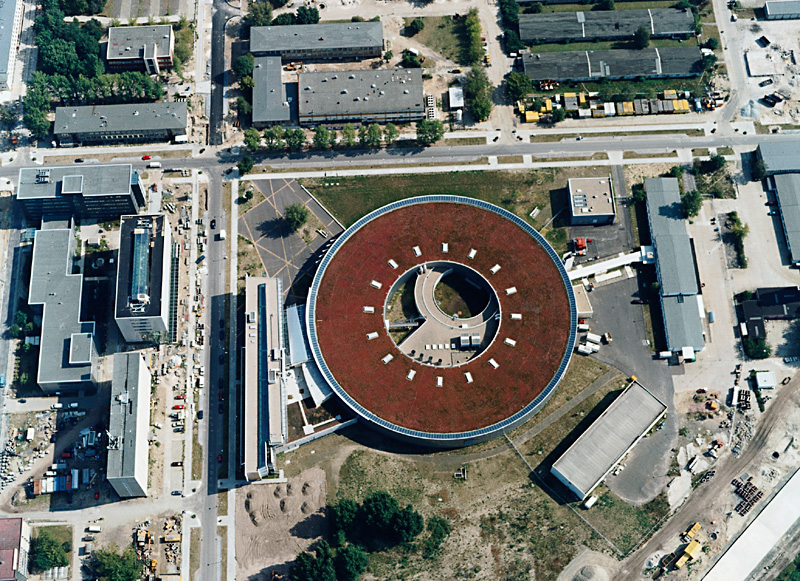The Helmholtz-Zentrum Berlin

Helmholtz Zentrum Berlin © Copyright: V. Mai / Helmholtz-Zentrum Berlin
At the Helmholtz Zentrum Berlin für Materialien und Energie (HZB), we conduct research on complex systems of materials that contributes to dealing with challenges such as the energy transition. The HZB research portfolio includes solar cells, solar fuels, thermoelectrics, and materials for new, energy-efficient information technologies (spintronics) or electrochemical energy storage. Research on these energy materials is closely connected with the operation and advanced development of the BESSY II photon source.
Social Media
BESSY II at HZB

Aerial photograph: BESSY II in Berlin-Adlershof © Copyright: Helmholtz-Zentrum Berlin.
BESSY II is a third-generation synchrotron radiation source that produces extremely bright X-ray light. BESSY II is a universal tool for studying an endless variety of samples, for example solar cells, materials for solar hydrogen production and quantum materials. Proteins can be studied for the development of new medicines, and meteorites and archaeological finds can be investigated using the soft X-ray light from BESSY II.
Researchers from all over the world can use this light for their experiments. BESSY II at HZB, Europe's dedicated soft X-ray source currently offers:
Beamlines
User Visits per year
Beamtime Campaigns per year
BESSY II Research Portfolio
Being a multi-disciplinary and multi-user facility, the research portfolio at BESSY II spans the range from physics (e.g. quantum physics in solids, superconductivity, magnetism, topological insulators, clusters, disordered systems), over chemistry (e.g. catalysis and artificial synthesis, real-time investigations of charge transfer), energy research (e.g. materials for energy conversion and storage, solar fuels, battery research, energy efficient information technology), biology (e.g. dental treatment, cells, bacteria), medical and pharmaceutical research (e.g. bio- and biomimetic materials, function mechanisms of drugs), to materials testing and cultural heritage investigations.
Research at BESSY II addresses the grand challenges most developed societies are facing.
A particle accelerator as a microscope. © Copyright: Helmholtz-Zentrum Berlin.

General Plan BESSY II © Copyright: Helmholtz-Zentrum Berlin
From BESSY II to the BESSY VSR


The BESSY II synchrotron radiation source at Helmholtz-Zentrum Berlin (HZB) is a 3rd-generation 1.7 GeV storage ring dedicated to the VUV and soft X-ray photon energy range, serving an international user community. The source and the instrument suite are very versatile and provide photons at a high average brilliance. Purpose-made insertion devices allows for energy, spatial, temporal and polarization control of the photon beam. BESSY II operation covers a multitude of operating modes from multi-bunch and multi-bunch hybrid as standard modes to single bunch, low- α operation and femtosecond-slicing for time-resolved experiments in the ps to fs regime.
HZB is currently implementing the upgrade of BESSY II to the BESSY VSR variable pulse‐length storage ring, which will enable users to choose between regular, long pulses and picosecond short pulses for time resolved experiments. In parallel HZB is identifying the user-driven requirements for a diffraction limited future light source in the soft X‐ray range (“BESSY III”). Highest stability enabling nanometer spatially resolved experiments with paramount spectral resolution will be a key aspect of this facility, for which the case of a combination of the VSR concept with a diffraction limited storage ring is evaluated in view of the photon source development expected for the decades to come.


While preserving the present average brilliance of BESSY II, the BESSY VSR upgrade adds the new capability of user accessible picosecond pulses at high repetition rate. In addition, high intensities for THz radiation with intrinsic synchronization of THz and X‐ray pulses can be extracted from BESSY VSR. BESSY II’s time structure is extremely well suited for Angular Resolved Time Of Flight (ARTOF) photoemission measurements. Within the context of the Uppsala Berlin joint Laboratory on next generation electron spectroscopy (UBjL), this method is developed further; it is currently available at 2 beamlines, one dedicated to sensitive samples (LowDosePES) and one to coincidence experiments.
Further instrumental highlights are the ARPES-stations 1-square and 1-cube for investigations of correlated electron systems, topological insulators and superconductors which allow for highest resolution (1meV) and in case of the 1-cube sample temperatures below 1K The X-ray microscopy activities at BESSY II are among the leading worldwide. Specifically, a spatial resolution of 10 nm has been achieved in transmission X-ray microscopy (TXM) and the gap in resolution and contrast between optical microscopes and electron microscopes has been closed which is of high relevance to life sciences.



